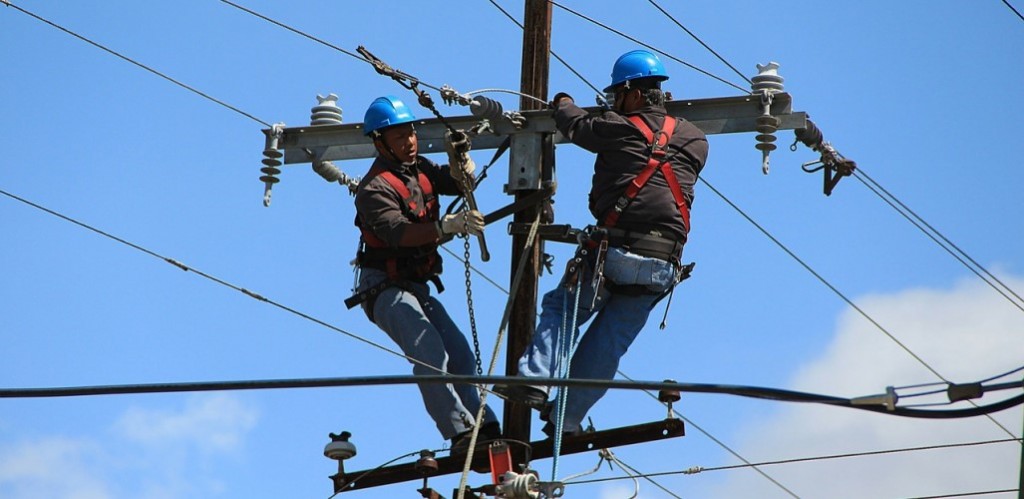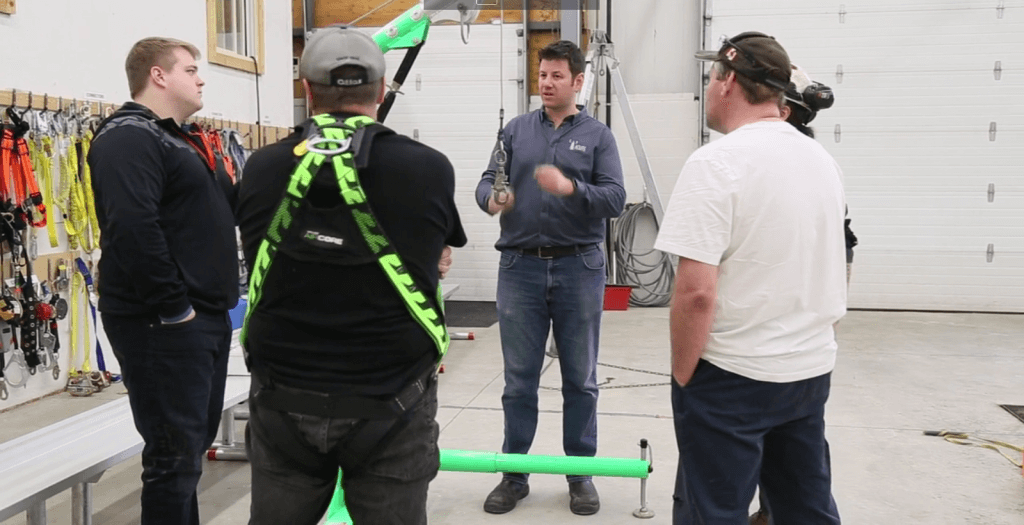Safety Topics in the Workplace: It is particularly important to make sure you know how to stay safe when you are working at heights from which you could potentially fall and injure yourself. Here are some basic guidelines that you should follow. Click on each one to learn more.
- Use the Proper Personal Protective Equipment
- Install a Protective Railing
- Use the Right Equipment and Use It Correctly ie. Scaffolds, Elevating Devices, and Ladders
- Get Proper Training
You might also be interested in the following topics:
What Does Working at Heights Training Include?
Where Can You Take Working at Heights Training?
If you are looking for proper Working at Heights training in Ontario, contact us.

Working at heights is one of the most important safety topics in the workplace that you need to understand
Safety Topics in the Workplace – Working at Heights
1. Use the Proper Personal Protective Equipment
Make sure that you are using the proper personal protective equipment required for the type of job that you are doing. Not all fall protection devices are the same nor are they the same quality. For example, if you are working around flammable materials or electricity, then your fall arrest systems need to protect against these types of hazards.
In addition, you need to check your harnesses and lanyards to make sure that they are in good condition before you use them each and every time. Check for signs of wear and tear and make sure that the D-rings are in good shape and not showing any signs of rust. Also, check that all of the straps and clasps are tight.

Safety topics in the workplace: Make sure your fall arrest equipment can protect you against hazards like electricity
2. Install a Protective Railing
A very effective way to protect yourself on an elevated workspace is to install railings around the edges and then remain within the railings while working. Railings are a very simple way of protecting workers from falling, however, it is not always possible to install them in all locations.
3. Use the Right Equipment and Use It Correctly ie. Scaffolds, Elevating Devices, and Ladders
Different situations will require different types of equipment for working at heights. It is important to evaluate the type of situation you are working in and choose the appropriate equipment. In addition, you want to make sure that you are using your equipment properly.
Scaffolds:
Scaffolding works well if you are doing work such as painting a house, brick and stone work, or plastering. Using scaffolds can, however, present many dangers to workers who are unaware of or inattentive to safe scaffold procedures. You want to make sure that your scaffolding is equipped with protective railings. Never climb or stand on the cross braces and guardrails and never work on scaffolding during a storm or if there are high winds.

Safety topics in the workplace: Never work on scaffolds during a storm
Elevating Devices:
Elevating Work Platforms (EWPs) such as scissor lifts and boom lifts can be safe solutions to working at height challenges. Unfortunately, lack of training, improper use and defective equipment can lead to serious accidents. Some basic safety procedures include:
- Make sure that you keep your gate closed or chain secured on the device at all times.
- Always keep both feet firmly planted on your work platform
- You should be properly tied off or secured to the engineered anchor point designed for your particular lift.
Ladders:
If you need to use a ladder in the workplace, there are several things that you should do to make sure you are safe including:
- Always maintain 3 points of contact with your ladder at all times. This means that you should always have 2 hands and one foot firmly placed on the ladder at all times or 2 feet and one hand. This means you should never carry something up a ladder in one hand. Either use a pulley or carry items in a tool belt.
- Make sure that you have at least 3 feet of the ladder extending above where you have to climb. Never climb all the way to the top rung of your ladder.
- Make sure that you have a safe ratio of rise and run (4:1) when placing your ladder. This means that for every four feet high that your ladder will reach, you need to place it one foot out from the structure it is leaning against. For example, if you need your ladder to reach 12 feet up a building, then the base of your ladder will need to be placed 3 feet out from the building.
If you use ladders, elevating devices, or scaffolding in your job, it is important to get the proper training on these pieces of equipment.

Safety topics in the workplace: Get training before working on elevated work platforms
4. Get Proper Training
Ontario requires that anyone working on a construction project who uses fall protection equipment must take working at heights training. Here is the criteria for your training as set out by the Ontario government:
- Your training must be approved by the Ministry of Labour, Immigration, Training and Skills Development’s Chief Prevention Officer
- Your training needs to be delivered by a training provider who has been approved by the Chief Prevention Officer
- Your training needs to be completed before you can use fall protection
- Working at heights training requirements are set out in O. Reg. 297/13: Occupational Health and Safety Awareness Training
According to O. Reg. 213/91: you will need to take working at heights training if you work on a construction project that is covered by O. Reg. 213/91 and you need to use any of the following fall protection methods:
- Travel restraint system
- Fall restricting system
- Fall arrest system
- Safety net
- Work belt
- Safety belt
There are, however, limited exemptions if you are a worker who is directly employed by an automobile manufacturer or assembler.

Safety topics in the workplace: Working at Heights training is mandatory in many cases
What Does Working at Heights Training Include?
A thorough working at heights training program will include both a theory component and a practical component. For example, if you take your training at ACUTE, you will learn the following:
Working at Heights Theory
This component will take 3 hours and will cover the following topics:
- Working at heights [WAH] and legislation
- WAH hazards
- Safe work plans and assessing and controlling WAH hazards
- The hierarchy of controls – application to WAH
- Fall prevention strategies and systems
- Fall protection systems
- Ladder safety
You will be given a written evaluation to ensure that you fully understand everything that you have learned.
Working at Heights Practical Component
The practical portion of the ACUTE training course will give you the necessary experience using the techniques that you learned in the theory module. This session will last 3.5 hours and will include:
- Fall prevention/protection system requirements and limitations
- A-B-C component selection, inspection and use
- Harness inspection, fitting exercise and evaluation
- Lanyard inspection exercise and evaluation
- Travel restraint, fall arrest set-up exercise and evaluation
- 100% tie-off exercise and evaluation
- Ladders, scaffolds and elevating work platforms
- Rescue plan – components and purpose
- Safe work strategies and safe anchor exercise
You will also be given a written evaluation at the end of this module to ensure that you have learned everything you have been taught. The following video explains more about this course.
ACUTE offers both a theory and a practical component to your working at heights training
Where Can You Take Working at Heights Training?
You can choose to either take your Working at Heights training at our world-class facility or if you prefer, we can come to your site. Our training facility features:
- Industry-standard health and safety equipment and technologies
- Simulation areas for a full suite of training programs (i.e. working at heights, confined space, and hazardous materials)
- Classroom facilities for lecture and technical training delivery
- Human dummies for confined space rescue and hazardous material controls

You can take your training at your facility or ours
You can trust ACUTE for the best safety training possible, including working at heights training. ACUTE’s experienced team members have been serving safety professionals for over 20 years. You can rely on ACUTE for hands-on, physically distanced, practical safety training to keep your employees safe in the workplace. ACUTE is dedicated to workplace safety and understands the importance of course and training provider approval. Why get workplace safety training with ACUTE? Here are just some of the benefits of working with ACUTE:

- Open Door Instructor-Student Partnership – ACUTE’s training services emphasize client participation. Staff foster relationships with clients and serve as a touchstone for advice anytime moving forward.
- Serving Your Team and Industry – With a vast array of clients in the manufacturing, construction, health, academic, and government sectors, ACUTE brings the best safety practices from across the spectrum to your workplace.
- 100 Years Combined Experience – ACUTE provides comprehensive health and safety training, on-site safety services, and consulting services. With over 100 years of combined experience, our company staff offer more than theoretical or abstract ideas. ACUTE offers solutions.
- Track Record of Success – ACUTE is rated 4.9/5 stars on Google reviews, demonstrating a commitment to our clients, quality, and passion for training.
Check out our course calendar for times and dates of our courses.
What Our Customers Are Saying…
“I work at the University of Guelph as an arborist. Ron Campbell provided a small socially distanced group and myself with working at heights training. Ron has a wealth of knowledge and kept everyone engaged with many “real life” examples of working at heights scenarios and facts. We have also received elevated work platform training with Patrick from Acute training. Patrick is also a very friendly, knowledgeable and engaging professional trainer. I truly believe that the best trainers are those with practical experience and the trainers at Acute have that locked down.”

